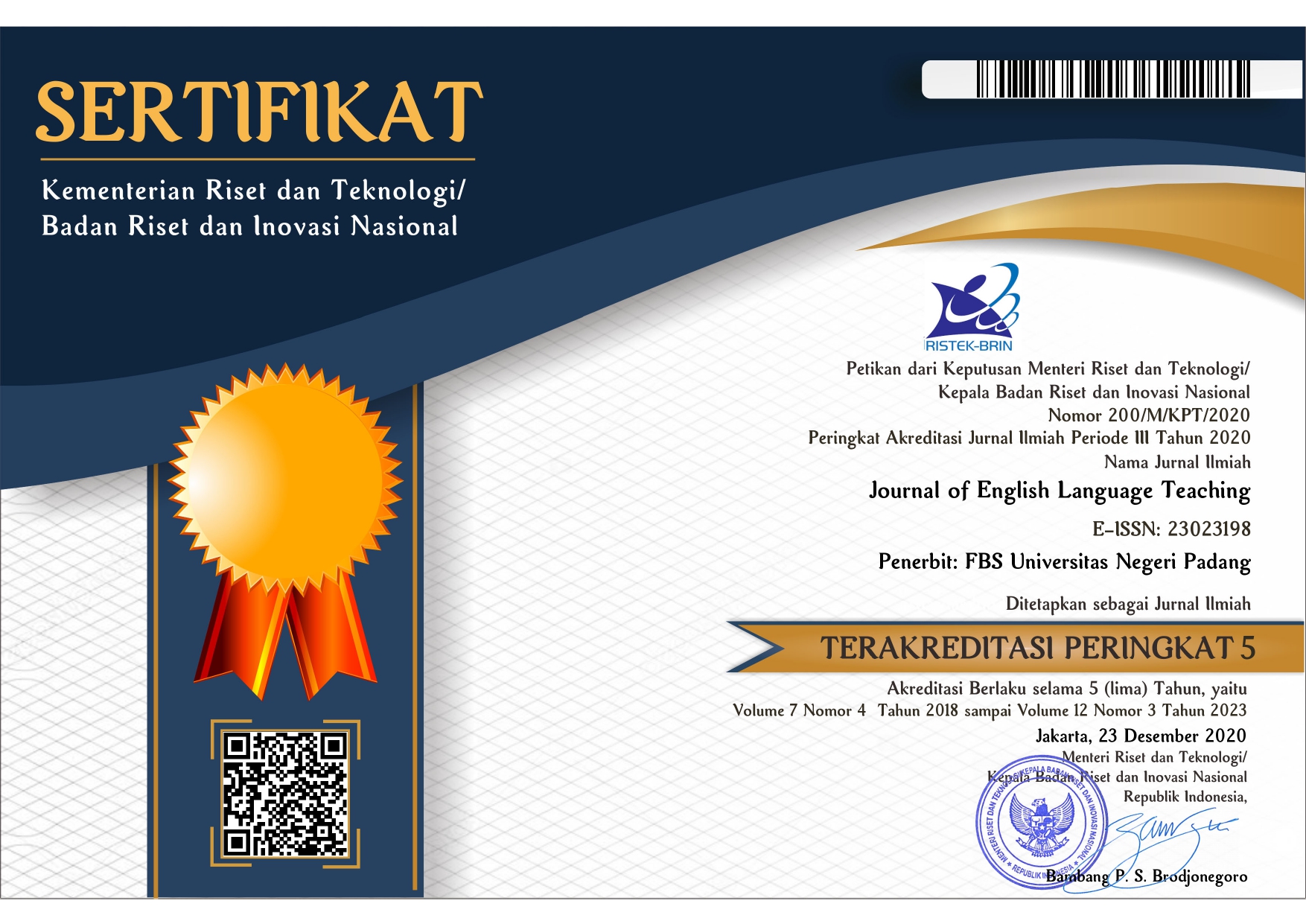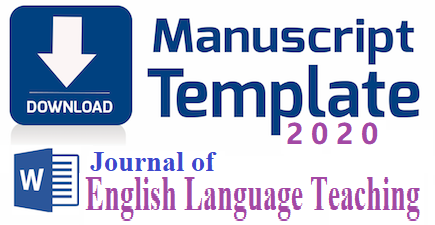Growing Gardening Metaphors the Activity in Teaching Writing Recount Text for First Grade of Senior High School
 ), Aryuliva Adnan(2),
), Aryuliva Adnan(2), (1) Universitas Negeri Padang
(2) Universitas Negeri Padang
 Corresponding Author
Corresponding Author
Copyright (c) 2019 Journal of English Language Teaching
DOI : https://doi.org/10.24036/jelt.v8i1.103310
Full Text:
 Language : en
Language : en
Abstract
Abstract
This paper deals with the use of Growing Gardening Metaphors Classroom Activity in teaching writing recount text for first grade of senior high school. Growing Gardening Metaphors can be used by teachers to make teaching and learning English classroom more enjoyable. This metaphor activity is used as the solution for the teacher to solve students’ problem in writing recount text in the first grade of senior high school. It helps the teacher in teaching writing recount text which motivates students to think more creative in considering the same function or activity both their experience and garden vocabulary while writing the text. Growing Gardening Metaphor can be applied for senior high school students in Indonesia. For doing this classroom activity, the teacher needs approximately 60 minutes to take the time required. It is appropriate to the grade X in senior high school which has two “teaching and learning hours” a week or 90 minutes for learning the English language based on the Indonesia Curriculum of 2013.
Keywords: Teaching writing, recount text, Growing Gardening Metaphors.Keywords
References
Burk, A. M. 2010. Write That Professional Article. English Teaching Forum. Number: 4.United States
Camacho, G. Z. 2005. Literacy Memoirs Involving Students in Meaningful Writing.EnglishTeaching Forum. Volume: 43. Number: 3. Colombia
Chen, Mei-Ling.2014.Teaching English as a Foreign Language through Literature.Theoryand Practice in Language Studies. Volume: 4. Number: 2. Finland: AcademyPublisher Manufactured
Elyildirin, S., and Ashton, S. 2006.Creating Positive Attitudes towards English as a ForeignLanguage.English Teaching Forum. Number: 4. Turkey
Hafis, A., Harahap, R., and Ansyari, K. 2018. Development of Recount Text TeachingMaterial Based on Local History Supported With Comic in Indonesian Learning inHigh School. International Journal of Education, Learning and Development. Volume: 6. Number: 4. European Centre for Research Training and Development UK
Hodgaon, Jenifer and Denne-Bolton, Sara. 2011. Classroom Activities: Growing GardeningMetaphors. English Teaching Forum. Number 3: p 50-52
Ibanez, J. I. 2012. Teaching English as a Foreign Language and Culture of The EnglishSpeaking Countries ThroughICT in and out of The Classroom Contexts. Valencia:University of Valencia. MA Dissertation
Joukoulian, A. 2016.Teaching English as a Foreign Language Today Integrated Approachversus Communicative Approach. The Lebanese University
Jozsef, H. 2001. Advanced Writing in English as Foreign Language. Lingua Franca Csoport
Jurianto, Salimah, and Kwary, D. A. 2014.Strategies for Teaching Writing in EFL Class ata Senior High School in Indonesia.Celt. Volume: 15. Number: 1
Kalra, M. B.,and Baveja, B. 2012.Teacher Thinking about Knowledge, Learning andLearners: A Metaphors Analysis. Procedia: Social and Behavioral Science 55 317-326
Koroglu, Z. C., and Ekici, G.2016. English Language Teacher Candidates’ Perceptions of Language Teachers:A Metaphor Study. International Journal of Languages’EducationandTeaching. ISSN:2198-4999. Number: 10.18298/ijlet.579
Korolyova, L. Yu., Voyakina, E. Yu., and Melekhova, N. V. 2016.Slang and Metaphors in the Process of Teaching English as a Foreign Language. DOI: 10,17277//voprosy
Kwary A. D. 2014. Strategies for Teaching Writing in EFL Class at a Senior High School inIndonesia. Celt, Volume 15, Number 1
Lowery, Denise. 2013. Helping Metaphors Take Root in the EFL Classroom. EnglishTeaching Forum. Number 1
Mahlios, M., Shae, D. M., amd Barry, A. 2010.Making Sense of Teaching ThroughMetaphors: a review across three studies.Routledge: Taylor and Francis Group. Teachers and Teaching: theory and practice. Volume: 16. Number: 1
McLean, Scott. 2012. Succsessful Writing. Volume: 1.0.
Mouraz, A., Pereira, A. V., and Monteiro, R. 2013.The Use of Metaphors in the Processes of Teaching and Learning in Higher Education.International Online Journal ofEducational Sciences. ISSN: 1309-2707
Nikitina, A. 2012.Improve Your Writing Skills. Bookboon
Saragih, N., Silalahi, R., and Pardede, H. 2014. The Effectiveness of Using Recount Text toImprove Writing Skill For Grade III Students of Kalam Kudus Elementary School 2 Pematangsiantar. IOSR Journal of Humanities and Social Science. Volume: 19. Issue:1. Version: XII
Schugar, J. T. 2008. Metaphors Instruction in One English Teacher’s Classroom: His Understanding, Instructional Practices, and Attitudes. University of Maryland:Dissertation
Simsek, M. R. 2014. A Metaphor Analysis of English Teacher Candidates’ Pre and PostCourse Beliefs about Language and Teaching.DicleUniversitesi ZiyaGokalpEgitim FakultesiDergisi, 22 230-247
Troia, Gary. 2014. Learning Through Writing. Evidence-Based Practices for WritingInstruction
Xiao, Fu. 2013. Motivational Strategies in Teaching English as Foreign Language—Applying Motivation Plan in TEFL. International Journal of Humanities and Social Science.Volume: 3. Number: 18. China
Yan, Guo. 2005. A Process Genre Model for Teaching Writing. English Teaching Forum. Volume: 43. Number: 3. China
 Article Metrics
Article Metrics
 Abstract Views : 550 times
Abstract Views : 550 times
 PDF Downloaded : 90 times
PDF Downloaded : 90 times
Refbacks
- There are currently no refbacks.
Copyright (c) 2019 Journal of English Language Teaching

This work is licensed under a Creative Commons Attribution-NonCommercial 4.0 International License.
















